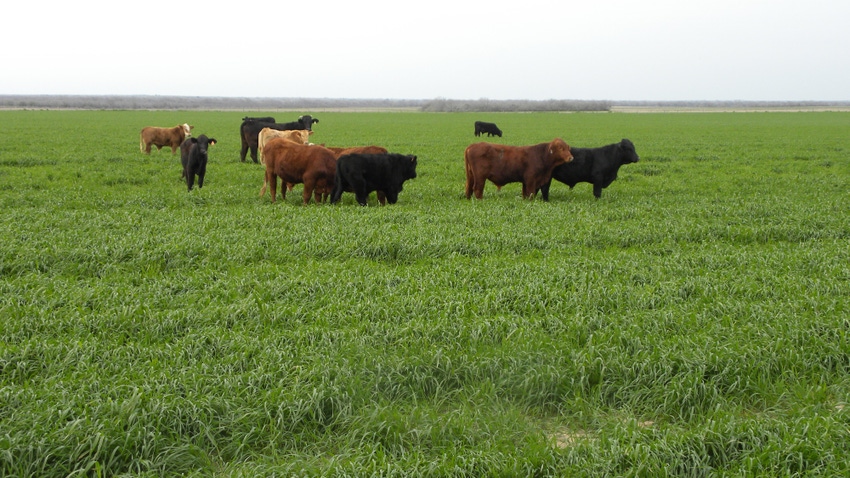May 11, 2023

Bloat is a common problem in ruminants if they can’t get rid of gas produced by rumen microbes during digestion. Putting hungry cattle on lush legume pastures such as alfalfa—especially in pre-bloom stage—is most dangerous. It becomes less dangerous once those plants are more mature, with lower protein level.
Wheat pastures can also cause problems. Nearly any pasture that is high in protein and low in structural fiber can be a risk under certain conditions, according to Bill Pinchak, beef cattle nutritionist, Texas AgriLife Research and Extension Center at Vernon, Texas.
“Lush-growing legumes, and winter cereal small grain pastures can present challenges; there are not many bloat interventions that work, once there is a significant problem,” he says.
“When grazing wheat pastures, many producers are hesitant to put out something for bloat prevention that does not also add value in terms of cattle performance. Products like Bloat Guard (poloxalene) are very effective if consistently consumed, but all they do is help prevent bloat.”
With any bloat interventions, cattle must be trained to consume them before they overeat.
“When stocker cattle are put on pasture, it takes time and investment to try to teach them what is safe to eat,” he says.
“This also applies to a mineral program, a different type of hay, or different pasture. If you plan to use any type of bloat intervention--an ionophore in a mineral, or a poloxalene block--the animals need to be exposed to that and trained to eat it before they go out on a bloat-prone pasture,” said Pinchak. They must already be consuming it, because once they start to bloat and don’t feel well, they won’t eat it.
Ways to reduce risk
“One way to reduce risk for bloat when cattle are first turned out on pasture is to make sure they are not hungry; fill them up on a good high-fiber hay, so they won’t overeat. Other things we’ve found, particularly with wheat pasture, is that how much bloat we see is related to the amount of pre-planting nitrogen we fertilize with. There will always be some bloat every year, but the goal is to not have mortalities,” says Pinchak.
“Normally on winter small grains (particularly wheat) we’ll have a one to two-week period in the spring when cattle experience some bloat. That bloat period can last 4 to 5 weeks and there may also be a bloat period in the fall for a week or two,” he says.
On alfalfa pastures the times to be careful are with lush new growth, and again in the fall after a frost. The more mature the plant, the less bloat potential. Putting cattle on a pasture a little later (or with alfalfa, waiting long enough after a killing frost that plants are no longer actively growing and are wilted/dried) can help reduce risk.
“A grass-legume mixture has less risk because cattle are eating some grass along with the legume and there is more fiber in the grass,” says Pinchak.
“Other things that help, at least on wheat pasture, is grazing management,” he says. “The taller the wheat when cattle go out there, the more frequently we see bloat. We did studies looking at pre-planting fertilization rates, comparing 30, 60 and 90 pounds of nitrogen. We saw bloat at all levels, at least for a day or two but found that with 90 pounds of fertilizer the risk for mortalities was very high. I tell people to use between 40 to 50 pounds maximum if they plan to graze those pastures. If they plan to pull the cattle off and later harvest that field for grain, they can come back after the cattle are gone and top dress with more nitrogen.
Raise calcium
“With mineral programs for cattle it also helps to get calcium levels as high as we can, because bloat is more likely to occur when there’s a calcium imbalance. It’s also helpful to include an ionophore in the mineral program. The nice thing about using an ionophore is that whether the cattle are at risk for bloat or not, you get a positive response in performance; it improves average daily gain,” he says.
“We’ve also worked with other products, including one enzyme-fortified product. We found it didn’t eliminate bloat but the bloat was less severe. There are options for bloat prevention, but the important thing is getting the product into the animal. If they won’t eat a mineral pack, some people use a molasses block mineral or low moisture tub that contains the bloat product,” he says.
“Another product that works pretty well is a liquid mix that is high in fat.If we add more fat to the diet, there will be less bloat. Bloat is often caused by formation of foam, and fat/oil tends to break up the foam. This is why corn oil, mineral oil, etc. works for treating acute bloat.If you can feed a supplement that’s high in fat, and cattle consume it, this can decrease the risk,” says Pinchak.
Some people provide long-stem hay for cattle to eat free choice while on bloat-prone pastures, such as big bales in the corner of a pasture. Cattle can address their fiber needs by eating a little hay.
Another tactic is to let the forage become more mature so it is not so lush, and graze it during a frost-free period. “Anything that upsets the photosynthesis process in the actively growing plant (such as frost) can cause bloat. With alfalfa or clover you can have bloat occur any time during the growing season, under certain conditions.”
If it’s a pure stand of alfalfa, let it get taller and more mature. If possible, have the alfalfa in a mix with grasses. There also some low-bloat legumes like sainfoin and cicer milk vetch that won’t bloat cattle.
About the Author(s)
You May Also Like




